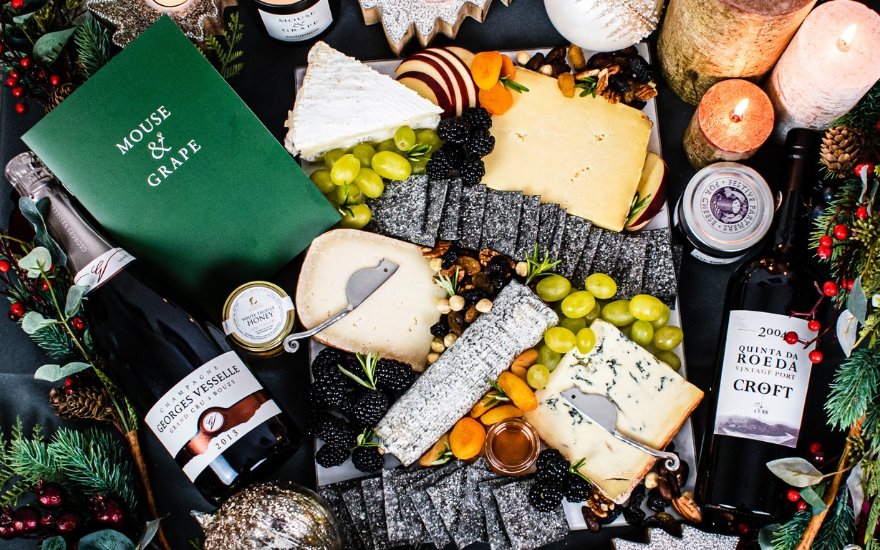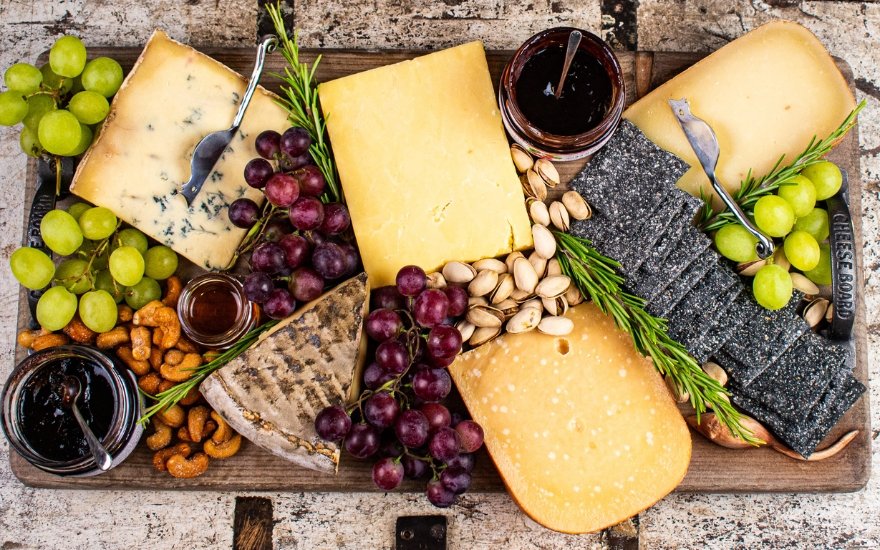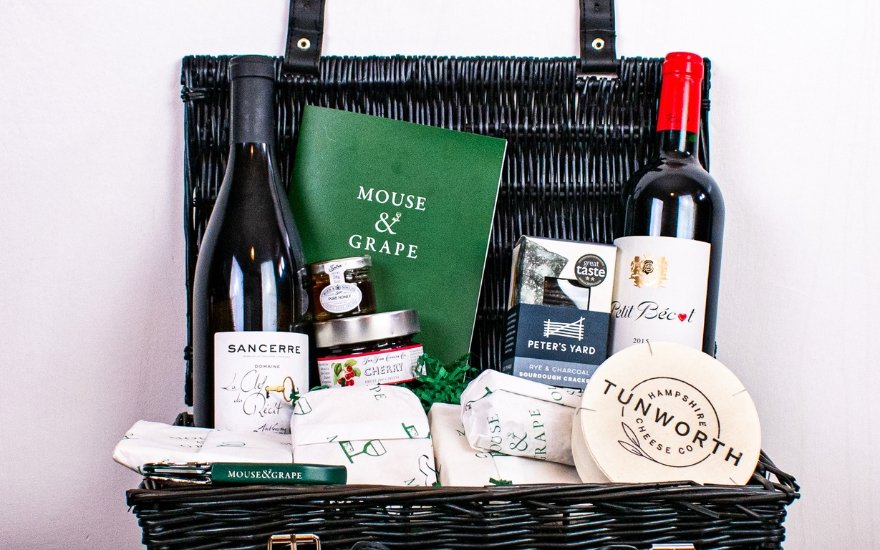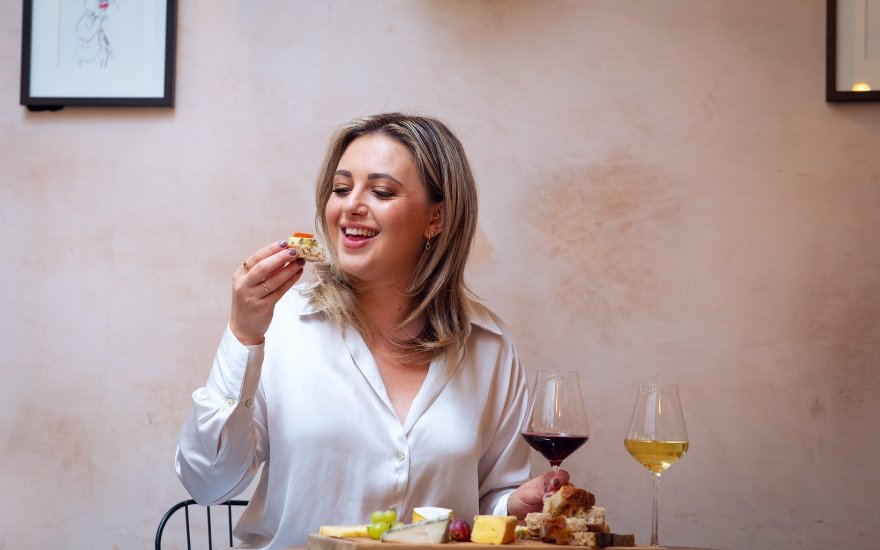Words by Jessica Summer, founder of Mouse & Grape and certified cheese and wine pairing expert.
Tasting cheese and wine is difficult and it takes time to learn how to identify the different flavours and aromas you are experiencing. When you first start, if all you are smelling and tasting is just cheese and wine that is okay, it takes practice! You have to train yourself to recognise flavours, the best way is to try different things and be mindful. Think what am I tasting? Why do I like it? It can also help to associate a specific memory with tasting a specific item of food which will help you remember how the food tastes, such as family holidays or romantic dinners!
When I run my tasting events I always recommend that my guests go with their first option on a flavour or aroma 99% of the time it is the correct one. When you over analyse and second guess yourself is where it goes wrong, trust your instincts! Before we dive into my favourite cheese and wine pairings recommendations I am going to explain the Mouse & Grape tasting system so you can fully experience the joy of pairing cheese and wine together.
I would always recommend starting with your wine first and tasting it on its own, then trying the cheese on its own and lastly, (the best bit!) enjoying them together. The approach to tasting wine and cheese is very similar. In both cases, you need to pay attention to the look, smell and flavours as well as the feel of the cheese.
How do you pair cheese and wine?
To experience the best flavours in your cheese and wine I would recommend avoiding strongly flavoured food and drink such as coffee before you taste as this will affect your ability to taste simple and complex flavours. It is useful to have good palate cleansers to hand. These include water, bread, crackers and apples to use between trying different combinations. Cheese and wine must both be served at the correct temperature to allow them to reach their most delicious potential. Different wines should be served at different temperatures. Typically white, rosé and sparkling wines are served chilled. Reds are typically served lightly chilled or at room temperature. It’s important to remove your cheese from the fridge, and its wrapping, 1-2 hours before serving. If your cheese is still cold when it is served, its flavour will be dulled.
THE LOOK
Wine: Hold your glass at an angle to identify the colour and the intensity. Is it white (lemon, golden or amber), red (purple, ruby or garnet) or pink (salmon or orange)? Pale, medium, or deep colour? Is it clear or cloudy? For the best results, examine your wine held against a white piece of paper and in bright natural light.
Cheese: Every cheese tells a story through its appearance so take a moment to look closely at the cheese. Examine the colours of both the exterior (the rind) and the interior (the paste). What type of cheese is it? Hard, soft or blue? Are the colours of the paste consistent and even throughout the piece? Look at the texture of the rind - are there any bumps, cracks, patterns or coloured moulds? Does the cheese have holes or salt crystals? Compare the centre of the cheese to the cheese next to the rind: what are the differences, or are they the same? Cheese loves to grow mould, so if your cheese has spent some time in the fridge you may find some surface mould has developed. Simply trim a thin layer off the surface – the cheese beneath will still taste exquisite. On the subject of mould, artisan cheeses can look very different to supermarket cheese: the cheesemakers focus on flavour over appearance. For example the goat’s cheese Rachel is washed regularly in a brine solution as the cheese matures. This gives it a pinky/grey rind with occasional orange and yellow spots which are naturally occurring and safe to eat.
THE AROMA
Wine: Put your nose a little way into the glass and take a big inhale, the deeper the better! What does the wine smell like? Don’t worry if at first you can’t smell much, you’ll quickly be able to identify more aromas with practice. First identify broad categories (like berries) then try to pinpoint the aroma (blackberries). You may smell: fruits, such as green apples, pears, cherries or blackcurrant; spices such as cinnamon or vanilla; earthy smells like soil, grass, hay; or woody aromas like oak, pine, or cedar. Now swirl the wine in your glass. This will introduce more oxygen to the wine, which will increase the flavour intensity. Can you detect the existing aromas more strongly, or even notice new aromas?
Cheese: There are a few similarities in the way we describe wine and cheese flavours. Both can have aromas that are lactic, earthy, grassy, nutty or floral. Pick up the cheese and bring it to your nose to take a big sniff. Some cheeses like Époisse or Roquefort will be easy to smell! What can you smell? Cheeses can smell animally, yeasty or mouldy. Can you smell grass or flowers? Can you smell a “farmyard” smell?
THE TEXTURE
Wine: Take a small sip of your wine but don’t swallow it yet! Let it sit on your tongue and warm the wine making it easier to detect. Then gently swish it around your mouth to get the full effect. Ask yourself:
What is the mouthfeel like (water, semi-skimmed milk or creamy)?
Is your mouth filled with saliva (telling us the wine is high in acid)?
Is the wine creating a drying sensation in the mouth thanks to tannins?
Cheese: The texture of cheese plays an important role in the evaluation of it. Take a small crumb of the cheese you are tasting and rub it between two fingers. Notice how easily (or not) it smears. Take a small bite, and let it sit on your tongue for a moment. Notice how firm or soft the cheese feels. As it warms up it will soften a little more. Now slowly and mindfully chew it. Is it soft and pliable? Does it melt in your mouth? Is it a hard cheese that breaks down into small chunks as you chew? Does the cheese coat the inside of your mouth?
THE FLAVOUR
Wine: Take a second sip and employ the “slurp” technique to aerate the wine (sucking air past your front teeth with the wine on your tongue). This will help you notice the flavours more easily. Ask yourself:
What flavours do you taste?
Can you taste the aromas you detected or have they changed?
Is the wine sweet, tart or bitter?
Are any elements standing out in a bad way, meaning the wine is unbalanced? (Acidity, tannin or sugar, for example?)
Swallow the wine and breathe out. Do the flavours change?
Do they linger or do they disappear quickly? This is known as the “finish”. Great wines have a pleasant finish that lingers and does not vanish quickly.
Cheese: When tasting the cheese for the first time think ‘less is more’ and take a small bite which will be easier for you to move around your mouth. Let it sit in your mouth for 5-10 seconds which is enough time for the cheese to warm up and release more powerful flavours making them easier to detect. The flavours in cheeses change and evolve the longer you keep them in your mouth. You may notice that a cheese might start being very salty but as you continue to chew it becomes sweeter and the diary flavours are more pronounced.
How to taste cheese and wine together
Pairing is the art of bringing two or more ingredients together to create a more delicious outcome. The best way to discover outstanding pairings is through trial and error, and sometimes great pairings can come from the most unlikely of combinations. It is important to remember that taste is subjective. I might love a wine, cheese or pairing but it might not be for you. For this reason, all Mouse & Grape hampers feature exceptional quality cheeses and wines that can be enjoyed on their own too, and I always add other pairing recommendations and recipes for you to try. Part of the fun is to discover your palate and experiment and try different combinations to find your ultimate cheese and wine pairings. That being said, there are cheese and wine combinations that I have put together in the Mouse & Grape hampers and tasting events that people love and I am excited to share some of the most popular ones with you here.
First, take a sip of wine and work through the Mouse & Grape tasting system above. Then use a palate cleanser and do the same with the cheese. Then take a bite of cheese and hold it in your mouth as you take a sip of wine and chew them together.
Ask yourself the following questions:
What flavours can I taste with them together?
Is either the wine or the cheese flavour dominant?
Is this combination more or less enjoyable than the cheese and wine alone?
When you are pairing cheese and wine together, you are either looking for two contrasting flavours which bring out the best in both such as the classic contrasting flavours of sweet and salt, or you are looking for a cheese and wine with similar flavour profile which will complement one another without overpowering creating a harmonious balance bringing out the best in both. One example of the former pairing would be Sauternes and Roquefort. A stunning example of the latter is 2 Year Aged Gouda with a Saint Émilion Grand Cru (the pairing combinations from the Mouse & Grape Old & Bold Christmas Hamper). Both the cheese and wine have big bold flavours which complement one another and don’t overpower. I love how the salt crystals in the cheese bring out the fruitiness in the wine. Another great example is Truffle Brie with Champagne, which can be found in the Mouse & Grape Ultimate Christmas Hamper. The high fat content in the brie coats your mouth in gooey goodness and then the refreshing sharp ultra-fine bubbles of the sparkling wine cleanse the palate and set you up for another bite! The rich creamy, mushroomy flavour of the truffle brie is complemented beautifully by the toasty notes in the champagne - a match made in heaven!
What are the best cheese and wine pairings?
Following my two pairing rules above, below are a selection of my favourite cheese and wine pairing combinations for you to try:
Sparkling Wines
Champagne: Aged Comté or Colston Bassett Stilton - a combination you can find in the Mouse & Grape Luxury Christmas Hamper
Cava: Manchego or other hard sheep milk cheese like Berkswell or Cora Linn
Prosecco: Burrata, Mozzarella or feta, I particularly like the Blackwood Cheese Graceburn
English Sparkling wine: Creamy soft cheeses like Hampshire cheese co Winslade or Tunworth.
White Wines
Sauvignon Blanc: Ash - coated goats cheeses like Valencay, Norton and Yarrow Brightwell Ash or Sainte Maure De Touraine - a combination from the Mouse & Grape classic Christmas Hamper.
Verdejo: Hard goats cheeses like White lake Dairy Rachel - you can find this delicious combination in the Mouse & Grape Eliza Hamper
Soave: With washed-rind cheeses like Taleggio or Nettlebed Creamery Highmore
Oaked Chardonnay: Eppoisé or Maida Vale made by Village Maid Cheese
Red Wines
Bordeaux Blend: Keen’s Cheddar - found in the Mouse & Grape Old and Bold Christmas Hamper
Pinot Noir: Saint Nectaire, Tomme De Savoire, truffle pecorino
Rioja: Appenzeller, Gruyere, Aged Comté
Sangiovese: Pecorino Sardo, Gorgonzola Naturale or Beauvale - a British cheese made in a similar style.
Rosé
South of France pale Rosé: Goats cheeses like Perroche, Sinodun Hill or Golden Cross
English Rosé: lactic cow’s milk cheeses like Cornish Yarg or Mrs Kirkhams Lancashire
Sweet wines
Sauternes: Roquefort or Époisses
Moscato d’Asti: Gorgonzola Dolce or Flor Di Langa
Tokaji: Fourme D’Ambert or Cote Hill Blue
Port: Stilton or Durrus
Jessica Summer is the founder of Mouse & Grape and a certified cheese and wine pairing expert. Mouse and Grape is a luxury online cheese and wine business that specialises in perfectly paired cheese and wine hampers, a cheese and wine subscription service, and corporate and private tasting events. Jessica is a cheese and wine writer and was a judge at The British Cheese Awards 2022, a finalist at the World Cheese Awards Young Cheesemonger of the Year Competition 2022, and a wine judge at this year's people’s choice drinks awards.
Using my knowledge, tasting experience and qualifications I select the best quality wines and cheeses to curate the ultimate cheese and wine pairing hampers and tasting events. I have drawn upon my experience in the industry to write this guide and I am excited to share my cheese and wine pairing secrets with you! In my opinion, cheese and wine has to be the most iconic and well suited pairing combination in the food and drinks world. Biting into one's favourite piece of cheese or sipping a beloved wine is already a very pleasurable experience but when you combine these heavenly flavours together you reach optimum indulgence and maximum enjoyment!
If you have any cheese and wine questions, would like to book Jessica for an event or try one of her mouth-watering cheese and wine hampers contact her through the website or on Instagram!





